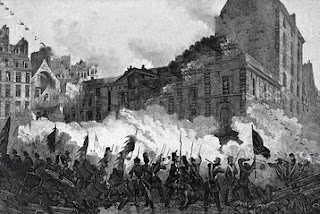This is one of the most popular misconceptions among most of the common people regarding aeroplane lift. The reason why so many people get it wrong is that:
(i) they encounter an explanation based on Bernoulli's principle in college textbooks and
(ii) The Bernoulli's principle is easy to understand.
There is actually nothing wrong with the statement that the air goes faster over the top of the wing but the fact that it relies on the "principle of equal transit times" is wrong. In other words, it assumes that the separated air( at the leading edge of the wing) must meet at the trailing edge at the same time. But why should they? In fact, the air going over the top of the wing gets to the trailing edge considerably before the air that goes under the wing.
The air going under the wing is actually slowed down from the "free-stream" velocity of the air. Also, this explanation based on Bernoulli's principle would imply that inverted flight is impossible. It also does not address acrobatic aeroplanes with symmetric wings.
The correct explanation of the lift is based on Newton's third law of motion. Newton's 3rd law, so very well known to even elementary physics students, states that for every action, there must be an equal and opposite reaction. When streams of air (streamlines) bend around the wings of an aeroplane, the air passing over the wing is bent down. This bending of air is the action. The reaction provides the lift on the wing. It is the change in the air's momentum that results in forces on the wing. Therefore, to generate lift, a wing must divert air down. The lift of the wing is equal to the rate of change of momentum of the air as it diverts down.
For greater lift, the wing must either divert more air (mass) or increase its downward velocity. This downward velocity behind the wing is called "downwash". An observer on the ground would see the air going almost straight down behind the plane.
This might appear confusing to a naive high school or undergrad student who has seen something like this as a depiction of the streamline flow around a wing. In this(wrong) picture, the air leaves the trailing edge along the same direction as it appeared at the leading edge. So, there is no net action on the air in this case and hence no lift on the wing!
As can be seen from the picture above, a complication occurs due to the effect of "upwash" at the leading edge of the wing. The upwash tends to create a negative lift and thus it needs to be compensated by pushing more air down. Also evident from the picture is the fact that the top surface of the wing does much more to move the air than the bottom. Hence, the top surface is the critical surface.
But how does a thin wing divert so much air and how does it divert the air down?
The answer to the first question is that as the air is bent around the top surface, it pulls on the air above it accelerating that air down in order to prevent voids from occurring. This pulling causes the pressure to become lower above the wing. So it's this acceleration of air in the downward direction that gives the desired lift.
Now the answer to the question of how it is diverted downwards. It is due to the so-called Coanda effect which describes the tendency of fluids to follow a curved surface. This is easily observable as you can readily check by holding a pipe horizontally under a tap such that the water streaming out of the tap just manages to touch the side of the pipe. The pipe would be seen to cause the water to wrap itself around the surface of the pipe. The reason why this happens is due to viscosity. In case of air, the viscosity is very small but large enough for the air molecules to stick to the surface. At the surface, the relative velocity between the surface and air molecules is exactly zero. Just above the surface, the fluid has a small velocity. The farther one goes away from the wing surface, the higher is the velocity until the external velocity is reached. Due to this velocity gradient, the fluid is bent towards the surface. Unless this bends too tight, the fluid follows the surface and the small volume of air stuck to the wing is called the "boundary layer".
The actual direction of the airflow around the wing is, however, more complicated.
One needs a mathematical aerodynamic description of lift for an accurate understanding of the forces on a wing, which is beyond my scope. However, as a physics student, it's good enough to understand that Newton's third law can correctly explain the lift of an aircraft.




